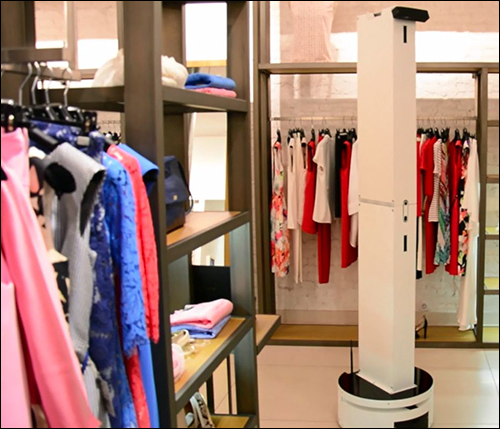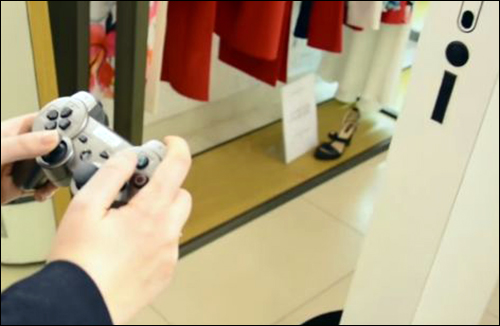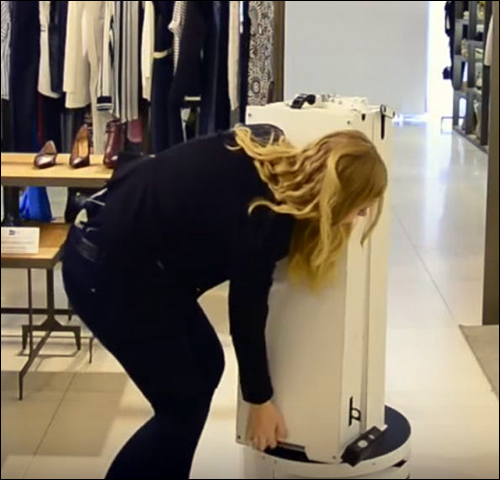May 03, 2016Keonn Technologies has announced a new version of its RFID tag-reading robot, known as AdvanRobot, that its systems-integration partner plans to pilot with a large U.S. retailer later this spring. The newest version, made commercially available in January 2016, uses its built-in ultrahigh-frequency (UHF) RFID reader and antennas, a laser sensor, a 3D camera and an onboard navigation system to report tag reads throughout a store. The system can also indicate where each tag was located when it was read, based on that tag's signal strength, and the robot's own understanding of its location on a map stored in the memory of its navigation system, as determined by sensor data collected from the laser and 3D camera.
The retailer, which has asked to remain unnamed, initially conducted limited tests on the robot for three months last summer. Now, says Ramir De Porrata-Doria, Keonn's co-founder and CEO, the company is launching a more extensive test of the latest version of the robot this year.

Keonn has been developing and revising its AdvanRobot for several years while piloting the system with retailers, with the goal of creating a solution that is easy to use and transport, as well as effective at reading RFID tags while navigating its way around a store. Other companies offer RFID-enabled robots, though Keonn says its own robot is unique because it is simple for a store employee to operate it via a smartphone, and because of multiple other features that make it especially easy to use—including the 3D camera and laser sensor, zone-level mapping, long battery life and ease of transport. The system also provides tag location, along with inventory counts.
"The main factor," De Porrata-Doria explains, "is not a technical one but a usability one. A robot is a technically sophisticated tool, but users should not have to have sophisticated or technical backgrounds to operate them."
Keonn, according to De Porrata-Doria, has been building improvements onto the robot that will make it easy for any sales clerk to operate it. If a sales associate is able to operate the robot to count inventory, he says, it will be used more frequently than one requiring IT knowledge or technical training on the part of the staff.
The AdvanRobot is part of Keonn's RFID platform for retailers—a suite of RFID-based solutions that communicate with its AdvanCloud cloud-based server. Such systems include smart fitting rooms; other interactive systems, such as smart mirrors; inventory-tracking solutions utilizing handheld readers; RFID-based payment and loss-prevention systems; and the robot. All data generated from the readers can be collected and interpreted by the AdvanCloud software, and be integrated with a user's own management software. In addition, Keonn offers an Android-based app so that users can access RFID data via their smartphones or tablets. With the app, users can also control the robot, viewing what it sees via its 3D camera and issuing instructions indicating where it should count inventory.
First, a user employs a joystick that comes with the robot to command it to move around the store, thereby creating a map. The map is then stored in the robot's memory, as well as in the AdvanCloud software, where it can be accessed via the AdvanRobot phone app. The system uses the store's Wi-Fi network to communicate with the robot, which comes with a laser sensor in its base and a 3D camera near the top of its payload, both designed to watch for obstacles. The laser sensor can detect any obstructions near the floor, while the 3D camera not only provides users with a view of where the robot is located within the store in real time, but also identifies obstacles that might not be present at the floor level (such as hanging garments) and automatically triggers the robot to stop and navigate around them.

In the case of a large store, the robot's inventory-tracking area can be divided into zones. In this way, a user can dispatch the robot to scan only certain zones—lingerie or furniture, for instance—and skip areas that do not require as frequent inventory checks or that may not contain RFID-tagged products. Guided by a phone or joystick during its first trip around the store, the AdvanRobot learns its inventory tracking route and creates a map within each zone, as well as the layout of zones throughout the store.
Once the maps are created and stored in the robot's memory, as well as on the cloud-based server, a sales clerk, manager or stock person could begin an inventory check. That worker would simply click a lever on the robot, enabling it to be manually pushed to a preferred starting point within the store. With the app on the phone, the user can indicate the zones in which tags need to be read (assuming multiple zones are being used), and launch the inventory check. The robot will then begin traversing the premises.
The AdvanRobot comes with the AdvanReader 150, a built-in EPC Gen 2 UHF RFID reader manufactured by Keonn and made with a ThingMagic M6e module running on an Impinj R2000 chip. Six Keonn Advantenna p22 reader antennas are installed on the robot's right and left sides. As the robot travels throughout the store, its reader captures the ID numbers transmitted by merchandise's RFID tags. Onboard software identifies which antenna receives the strongest transmission for each tag, and links that data with the robot's location, based on its navigation system. If the robot determines that the area contains a large volume of tags, it slows its speed, while if there are fewer tags, it moves more quickly. The robot can also circle back and capture reads a second time if the results do not match the tag IDs expected for that area.
The RFID data is stored on the cloud-based server so that store managers can view the information from a remote location. Individuals using the app can view the tag-reading results as the inventory-checking process is underway, as well as ascertain where the robot is located by checking the camera's view. In addition, users can make requests for changes to the robot's instructions in real time if they so choose—to conduct a follow-up inventory check of a specific zone, for example.
The new version of the robot offers multiple improvements intended to make it easier to use than its predecessor, De Porrata-Doria reports. Its built-in battery has a longer life than the previous version—14 hours before recharging is required. It can read tags faster and, therefore, accomplish an inventory check faster, and is designed to be easier to maintain since its battery and electronics can be removed with the click of a lever. The robot itself is designed to be easily moved from one location to another. Its six-foot-tall upper body folds in half so that it can roll under low ceilings or overhangs. The upper body can also be entirely detached from its motorized 10-inch-tall base so the robot can be transported in two pieces.

The AdvanRobot moves at a maximum speed of 1 meter (3.3 feet) per second, reading up to 400 tags per second. The robot has a maximum read range of 20 feet.
The American retailer tested the robot at a single store last summer to ascertain its ability to interrogate tags and create inventory maps for the robot to follow. The next pilot, scheduled to begin in May, will allow store personnel to test the robot in normal inventory-checking mode in a real-world scenario, such as after the store closes each night. The retailer wants to determine how quickly and effectively the robot can capture tag reads. It is important for this and other customers, De Porrata-Doria says, that the robot be able to conduct an inventory count of an entire store during the night hours when a store is closed. If the pilot goes well, the company will then consider whether to deploy the robot at its other locations.
Keonn sells its products through systems-integration partners around the world, De Porrata-Doria says, and those partners are now in discussions with other potential customers in Europe, North America and Asia. Keonn will demonstrate the latest version of the robot at its booth (#1012) during next week's RFID Journal LIVE! conference and exhibition, taking place on May 3-5, in Orlando, Fla.


